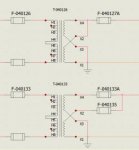TonyTurney
Member
- Location
- Ridgeway, Virginia
In the UL508A standard for industrial control panels, section 35.2.2.1 states: “35.2.2.1 A set of branch circuit fuses or an inverse-time circuit breaker provided for both the primary and secondary sides of a power transformer shall be sized in accordance with Table 35.2. A transformer with multiple secondary windings shall be provided with a set of branch circuit fuses or an inverse-time circuit breaker for each secondary sized in accordance with Table 35.2” [emphasis added].
Does this require that each winding of a dual-voltage transformer have separate protection? Or is a parallel connection of two windings for the lower voltage still considered one secondary, and "each secondary" relates to something other than simply interconnecting the windings of a dual voltage 120/240 transformer, for instance?
The statement in the code refers to “branch circuit fuses” – that would seem to put the emphasis on protecting the conductors, rather than the windings, with both windings considered part of the same circuit.
In the diagram below, a 480/240 - 240/120 transformer is shown with a 480 volt primary supply and a 120 volt secondary connection. In the upper circuit, fuse F-040127A is used after the parallel connection of both windings, while in the lower circuit fuses F-040133A and F-040135 protect each winding separately before the parallel connection. I have never seen this connection specified.

Also, if the intent is to protect the transformer windings, wouldn't the same apply to a dual-voltage primary, as well, say, if I used the same 480/240 - 240/120 transformer with a 240 volt primary supply?
Thanks,
Tony
Does this require that each winding of a dual-voltage transformer have separate protection? Or is a parallel connection of two windings for the lower voltage still considered one secondary, and "each secondary" relates to something other than simply interconnecting the windings of a dual voltage 120/240 transformer, for instance?
The statement in the code refers to “branch circuit fuses” – that would seem to put the emphasis on protecting the conductors, rather than the windings, with both windings considered part of the same circuit.
In the diagram below, a 480/240 - 240/120 transformer is shown with a 480 volt primary supply and a 120 volt secondary connection. In the upper circuit, fuse F-040127A is used after the parallel connection of both windings, while in the lower circuit fuses F-040133A and F-040135 protect each winding separately before the parallel connection. I have never seen this connection specified.

Also, if the intent is to protect the transformer windings, wouldn't the same apply to a dual-voltage primary, as well, say, if I used the same 480/240 - 240/120 transformer with a 240 volt primary supply?
Thanks,
Tony

